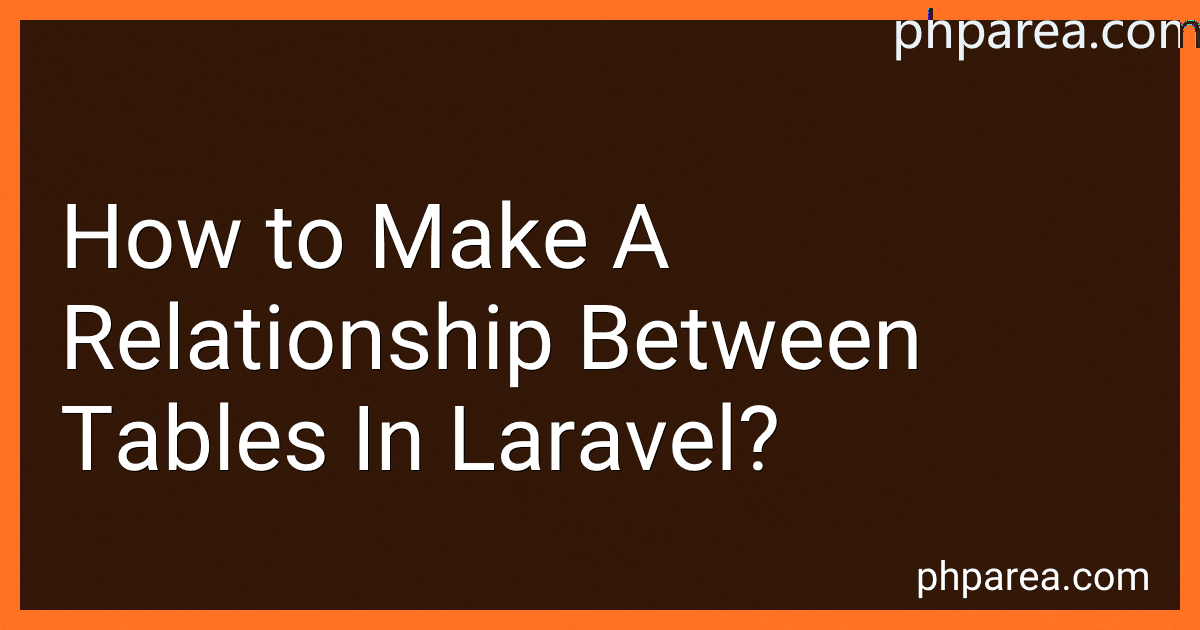Best Database Relationship Guides to Buy in December 2025
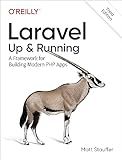
Laravel: Up & Running: A Framework for Building Modern PHP Apps


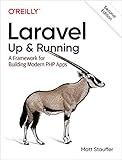
Laravel: Up & Running: A Framework for Building Modern PHP Apps


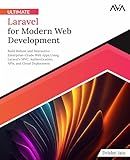
Ultimate Laravel for Modern Web Development: Build Robust and Interactive Enterprise-Grade Web Apps using Laravel's MVC, Authentication, APIs, and Cloud Deployment (English Edition)



Architecture of complex web applications. Second Edition.: With examples in Laravel(PHP)



Laravel: Up and Running: A Framework for Building Modern PHP Apps



Practical Laravel: Develop clean MVC web applications



Laravel: Learn By Coding



Little Traveler Board Book Set
- ENGAGING BOARD BOOKS EXPLORE GLOBAL CULTURES AND WILDLIFE!
- STURDY DESIGN WITH 8 CHUNKY PAGES PERFECT FOR YOUNG READERS.
- BRIGHT, VIBRANT ILLUSTRATIONS CAPTIVATE AND EDUCATE KIDS!


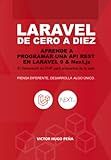
Laravel de cero a diez: Aprende a programar una API REST en Laravel 9 & Next.js (Spanish Edition)


In Laravel, relationships between tables are established using the Eloquent ORM (Object-Relational Mapping) that simplifies database interaction. To create a relationship between tables, you need to define the relationship methods in the corresponding Eloquent models.
- One-to-One Relationship: To create a one-to-one relationship, add a foreign key to the table you want to relate. In the model representing the table, define a hasOne or belongsTo method, depending on the relationship direction. Use the hasOne method in the primary model to relate to a single record in the related model. Use the belongsTo method in the related model to define the inverse relationship.
- One-to-Many Relationship: In the table that "belongs to" another table, add a foreign key column. In the model representing the table, define a hasMany method to relate it to the other model. In the other model, define a belongsTo method to specify the inverse relationship.
- Many-to-Many Relationship: Create an intermediate table that holds the foreign keys of both tables. In each table's model, define a belongsToMany method to relate it to the other table's model. Laravel will automatically handle querying the intermediate table.
These relationship methods can be further customized by passing additional parameters, such as column names and table names, depending on your database structure.
Once the relationships are defined, you can easily access related records using properties and methods provided by Eloquent. Laravel handles the necessary SQL queries behind the scenes, allowing you to work with related data effortlessly in your application.
How to retrieve related records using the "has" method in Laravel?
To retrieve related records using the "has" method in Laravel, you can follow these steps:
- Set up the relationship between two models. For example, if you have a "User" model and a "Post" model, you can define a one-to-many relationship in the "User" model using the "hasmany" method:
public function posts() { return $this->hasMany(Post::class); }
- Once the relationship is set up, you can use the "has" method to retrieve records that have a related model. For example, to retrieve all users who have at least one post, you can use the "has" method like this:
$usersWithPosts = User::has('posts')->get();
- Additionally, you can specify additional conditions for the related records by chaining the "whereHas" method. For example, to retrieve users who have at least one post in a specific category, you can use the following code:
$usersWithSpecificPosts = User::whereHas('posts', function ($query) use ($category) { $query->where('category', $category); })->get();
In this case, the closure within the "whereHas" method allows you to apply additional conditions to the related "posts" table.
By using the "has" method in Laravel, you can easily retrieve related records based on the specified relationships.
What are the different types of Laravel relationships?
There are several different types of Laravel relationships:
- One-to-One: In a one-to-one relationship, each record in the primary table is associated with only one record in the related table and vice versa.
- One-to-Many: In a one-to-many relationship, a single record in the primary table is associated with multiple records in the related table. However, each record in the related table is associated with only one record in the primary table.
- Many-to-One: A many-to-one relationship is the inverse of a one-to-many relationship. Here, multiple records in the primary table are associated with a single record in the related table.
- Many-to-Many: In a many-to-many relationship, multiple records in the primary table are associated with multiple records in the related table. This is achieved by using an intermediate table that contains foreign keys from both tables.
- Has One Through: This relationship allows you to define a one-to-one relationship through another relationship. For example, if a User model has a Profile model, and the Profile model has an Address model, you can define a "has one through" relationship to access the address information from the User model.
- Has Many Through: Similar to "has one through," this relationship allows you to define a one-to-many relationship through another relationship.
- Polymorphic: A polymorphic relationship allows a model to belong to more than one other model on a single association. This is useful when a model can belong to multiple types of other models.
- Has Many Inverse: This relationship is similar to a conventional one-to-many relationship, but in reverse. It allows you to define a relationship where a model owns many instances of another model.
These are the main types of relationships in Laravel, and each one has its own use cases depending on the application requirements.
How to count related records in Laravel relationships?
To count related records in Laravel relationships, you can use the count method provided by Laravel's Eloquent ORM. Here's an example:
Assuming you have two models User and Post, where a user can have multiple posts:
- Define the relationship in the User model:
class User extends Model { public function posts() { return $this->hasMany(Post::class); } }
- Retrieve the user and count their related posts:
$user = User::find(1); $postsCount = $user->posts()->count();
In this example, we first retrieve the user with id 1. Then, using the posts relationship method defined in the User model, we can call the count method to get the total count of the user's posts.
You can also eager load the related posts to avoid the N+1 problem:
$users = User::withCount('posts')->get(); foreach ($users as $user) { echo $user->posts_count; }
In this case, we use the withCount method to eager load the count of related posts for each user. We can access the count using the posts_count attribute on each user instance.
What is the inverse of a relationship in Laravel?
In Laravel, the inverse of a relationship refers to the relationship on the other side of a one-to-one or one-to-many relationship.
For example, if you have a one-to-many relationship between a User model and a Post model, where a User can have multiple posts, the inverse of this relationship would be defined on the Post model as a belongsTo relationship to the User model. This allows you to access the user that owns a post.
Similarly, if you have a one-to-one relationship between a User model and a Profile model, where each user has one profile, the inverse of this relationship would be defined on the Profile model as a belongsTo relationship to the User model. This allows you to access the user associated with a profile.
The inverse of a relationship helps in retrieving the associated parent model(s) from the child model(s) without having to explicitly define the relationship on both sides.
How to handle cascading deletes in Laravel relationships?
In Laravel, cascading deletes can be handled using the onDelete() method in the relationship definition.
- Determine the relationship type: Identify the type of relationship between the models. For example, the relationship could be one-to-one, one-to-many, or many-to-many.
- Define the relationship in the model: In the model that has the foreign key, define the relationship method using the appropriate relationship type. For instance, if it is a one-to-many relationship, use the hasMany() method.
- Add the onDelete() method: Inside the relationship method, use the onDelete() method to specify how to handle cascading deletes. The onDelete() method takes a parameter that corresponds to the desired behavior when the parent record is deleted. Some of the available options are "cascade", "restrict", "set null", and "no action". "cascade": This option will delete both the parent and related child records. "restrict": This option will prevent the deletion of the parent record if there are related child records. "set null": This option will set the foreign key of the child records to null when the parent record is deleted. "no action": This option will not perform any action on the child records when the parent record is deleted.
Here's an example of how to handle cascading deletes in Laravel:
class User extends Model { public function posts() { return $this->hasMany(Post::class)->onDelete('cascade'); } }
class Post extends Model { // ... }
In this example, when a User is deleted, all associated posts will be deleted as well due to the cascade option provided in the onDelete() method.
Remember to run the necessary database migrations or make changes to existing tables to ensure the foreign key constraints are properly set up to support cascading deletes.
